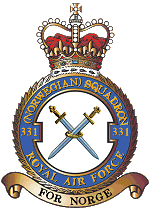
331 SQUADRON
The Place
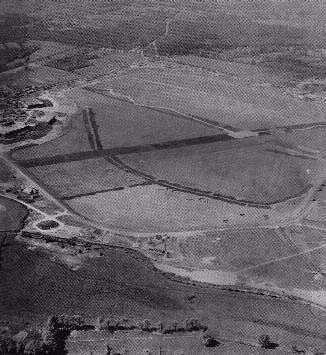
During the first world war North Weald, east of London was the base for the pilots which defended the capitol against Zeppeliners and bombers. In the years 1942-44 the airfield was the base for the norwegian fightersquadrons. The curving light line crossing the airfield is camouflage and is supposed to look like a river. The planes by the curving asfeld strip are one of the norwegian squadrons.
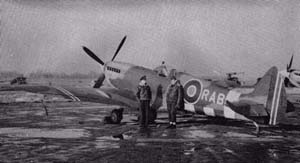
|
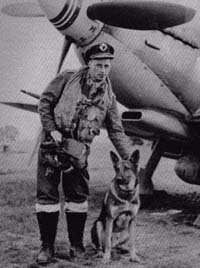
|
|---|---|
| The CO of the 132 (N) Wing, Lt-Colonel Helge Mehre(left) and Lt-Colonel Rolf Arne Berg in front of one of the wing's spiftires. The plane belonged to Berg and carried his initials. Not long after this picture was taken Berg was shot down in this plane. | The dog "Varg" met the 331 sqn on the Orchney-islands and became the 331 sqn mascot. "Varg" allso became the perfect squadron dog which knew its rights as well as its responsibilities. The dog had many owners over the years, when his current owner died, he was passed onto another pilot. Here "Varg" is taken care of by captain Ragnar Dogger |
The Men
 lt-colonel Rolf Arne Berg from Orkanger, pilot and wing commander flying of the 132 Norwegian wing.
He was one of the most dearly held officers. A no bragging attitude, allways cheery and eager to meet germans in a dogfight. After finishing his last mission in the war he asked permission to do just one more. He never returned from that mission. He was killed by german flak and the whole wing morned his loss.
lt-colonel Rolf Arne Berg from Orkanger, pilot and wing commander flying of the 132 Norwegian wing.
He was one of the most dearly held officers. A no bragging attitude, allways cheery and eager to meet germans in a dogfight. After finishing his last mission in the war he asked permission to do just one more. He never returned from that mission. He was killed by german flak and the whole wing morned his loss.
|
 Denmark did'nt have its own free airforce. However a handfull of eager danes joined the Norwegian fightersquadrons. lt-colonel Kaj Birksted was one of them. He was educated as a military aviator in Denmark and became one of the 331 sqn's greatest "Aces". He was dearly held by everyone, as an officer, instructor and friend. Here he is in a characteristic situation while demonstrating the tactics he used to score his most recent kill. Birksted didn't follow the wing over to the continent. Shortly before the wing was sent over, Birksted was transferred to a position in the HQ.
Denmark did'nt have its own free airforce. However a handfull of eager danes joined the Norwegian fightersquadrons. lt-colonel Kaj Birksted was one of them. He was educated as a military aviator in Denmark and became one of the 331 sqn's greatest "Aces". He was dearly held by everyone, as an officer, instructor and friend. Here he is in a characteristic situation while demonstrating the tactics he used to score his most recent kill. Birksted didn't follow the wing over to the continent. Shortly before the wing was sent over, Birksted was transferred to a position in the HQ.
|
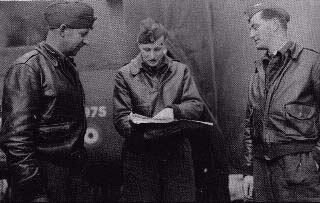 The three people in charge of the 132 (N) wing. Lt-colonel Helge Mehre flanked by his second in command
major Wilhelm Mohr (right) and c.o. of the technical unit major Sverre Barkald (left)
The three people in charge of the 132 (N) wing. Lt-colonel Helge Mehre flanked by his second in command
major Wilhelm Mohr (right) and c.o. of the technical unit major Sverre Barkald (left)
|
Highlights
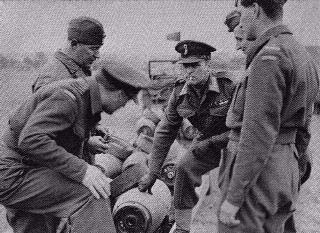 The Chief of defense and His royal higness Prince Olav (center) visited
the Norwegian squadrons several times. Here he is visiting the 132 wing
at Grimbergen Belgium.
The Chief of defense and His royal higness Prince Olav (center) visited
the Norwegian squadrons several times. Here he is visiting the 132 wing
at Grimbergen Belgium.
|
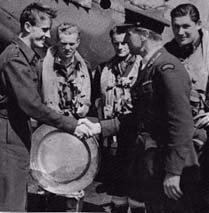 A round figure is reached. The Norwegian squadrons has reached confirmed kill number
100, and captain Svein Heglund recieves a tin-dish on behalf of the squadrons.
A round figure is reached. The Norwegian squadrons has reached confirmed kill number
100, and captain Svein Heglund recieves a tin-dish on behalf of the squadrons.
|
Day to day life
 The "service" wasn't allways too good during the campaign on the continent.
The filling of fuel was for instance done by hand from 20 liter cans.
Every man, pilot as well as groundcrew had to take part in this.
The "service" wasn't allways too good during the campaign on the continent.
The filling of fuel was for instance done by hand from 20 liter cans.
Every man, pilot as well as groundcrew had to take part in this.
|
 The groundcrew was allways ready to take care of each plane as they arrived from their missions,
and make them ready for the next. The weapon specialists took care of the guns while amunition-stores
and fuel was replenished.
The groundcrew was allways ready to take care of each plane as they arrived from their missions,
and make them ready for the next. The weapon specialists took care of the guns while amunition-stores
and fuel was replenished.
|
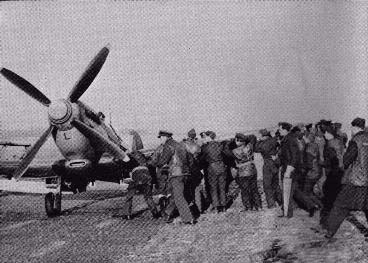 There were quite a few occasions where the pilots lost control of the spitfires when
landing. This result was that they often ended up in the "potato" fields, like here in
Schijndel in the northern part of the Netherlands. Only raw manpower could get it back
on its tracks
There were quite a few occasions where the pilots lost control of the spitfires when
landing. This result was that they often ended up in the "potato" fields, like here in
Schijndel in the northern part of the Netherlands. Only raw manpower could get it back
on its tracks
|
 Often when returning from a mission they would be met by a runway full of water and mudpools.
The pilots often had to do "slalom" to avoid the worst ones.
This picture is from schijndel.
Often when returning from a mission they would be met by a runway full of water and mudpools.
The pilots often had to do "slalom" to avoid the worst ones.
This picture is from schijndel.
|
 Far north in the home of fog, somewhere in the Netherlands. This kind of weather
often meant being grounded and long waiting hours.
Far north in the home of fog, somewhere in the Netherlands. This kind of weather
often meant being grounded and long waiting hours.
|
 Weapon specialists inspecting the remains of a V-1 Buz bomb which had been intercepted and downed
not far from the barracks at Woensdrecht.
Weapon specialists inspecting the remains of a V-1 Buz bomb which had been intercepted and downed
not far from the barracks at Woensdrecht.
|
 Freewatch on North Weald in the sunny walls outside the officersmess.
The time on North weald were later remembered as something close to paradise.
Freewatch on North Weald in the sunny walls outside the officersmess.
The time on North weald were later remembered as something close to paradise.
|
 The spitfire could carry three bombs, two under the wings like shown here on this photograph.
Only this is not bombs but beerkegs. Coming back from Great Britain and onwards to the continent
the norwegian pilots gladly mountet the kegs on the bombholds, where the bear could be cooled
going through the higher altitudes
The spitfire could carry three bombs, two under the wings like shown here on this photograph.
Only this is not bombs but beerkegs. Coming back from Great Britain and onwards to the continent
the norwegian pilots gladly mountet the kegs on the bombholds, where the bear could be cooled
going through the higher altitudes
|
Drama
 There was hardly a day when there wasnt a plane returning back with greater or smaller damage done to the plane.
Captain Egil Ullstein takes a look at his plane after landing. An AA-grenade has taken a big bite off his rudders.
There was hardly a day when there wasnt a plane returning back with greater or smaller damage done to the plane.
Captain Egil Ullstein takes a look at his plane after landing. An AA-grenade has taken a big bite off his rudders.
|
 The guy at the stick in this plane was pretty close death when a machinegun bullet hit the
cocpitglas in front of him.
The guy at the stick in this plane was pretty close death when a machinegun bullet hit the
cocpitglas in front of him.
|
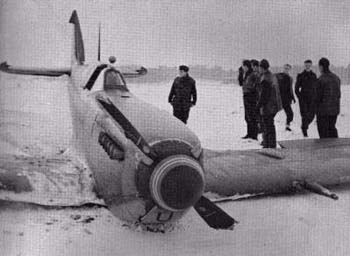 On several occations the undercarriage failed on landing. This pilot still had his share of luck.
The plane slid gently on the snow until it came to a halt, and he was safe. The plane however
didn't look as good as the pilot when it finally stopped.
On several occations the undercarriage failed on landing. This pilot still had his share of luck.
The plane slid gently on the snow until it came to a halt, and he was safe. The plane however
didn't look as good as the pilot when it finally stopped.
|
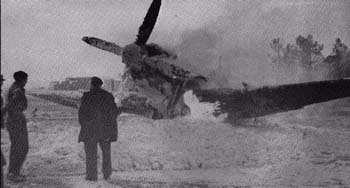 Often crowded airfields in bad conditions could create accidents when landing. Luckily the pilot usually got out,
and many of the planes could be repaired. Fire on landing did happen on occation as here on Woensdrecht.
The pilot came to no harm, but the plane was condemnable. At least it gave a realistic excercise in firefighting.
Often crowded airfields in bad conditions could create accidents when landing. Luckily the pilot usually got out,
and many of the planes could be repaired. Fire on landing did happen on occation as here on Woensdrecht.
The pilot came to no harm, but the plane was condemnable. At least it gave a realistic excercise in firefighting.
|